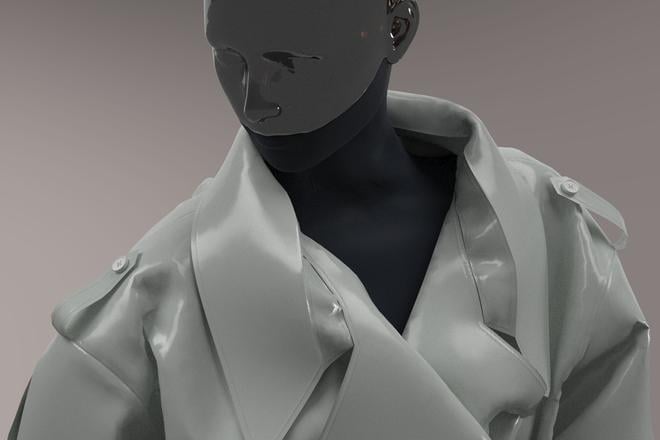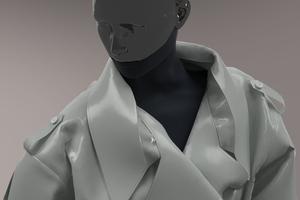If you haven’t heard of her yet, rest assured that a lot of people who live – and dress – online have. Katarína Mydliarová is Slovakia’s first well known “digital fashion” designer.
Just a year ago Mydliarová – the founder of Metarials, a studio that uses 3D fashion design software to create virtual clothes – organised the first digital fashion pop-up in Slovakia. Several weeks before Christmas, Mydliarová was invited to showcase her latest designs, virtual and physical, at the Fashion Map Weekend in Bratislava, providing people who love fashion with a virtual-reality experience.
But what, you might be wondering, is “digital fashion”?
On the “Nová Doba Udržateľná” (New Sustainable Age) podcast in December 2022, co-hosted by Katarína Hutyrová, owner of the Nosene second-hand clothing shop, Prague-based Mydliarová was asked to explain what the concept entails. She defined it as “any virtual display of clothes made with different digital technologies and software.” She went on to say that digital fashion has its origin in the gaming industry.
Examples of digital fashion can range from pictures of garments posted online, playful augmented-reality lenses and static filters for clothing that social media users can add to their images or videos on apps like Instagram and SnapChat, clothing worn by characters in the digital world, to virtual clothes that avatars wear and people can watch while wearing virtual-reality headsets.
Mydliarová came across digital fashion during her studies at Tomáš Baťa University in Zlín, Czech Republic, during which she also got the chance to explore fashion design in the UK, Germany and South Korea. In 2021, she chose digital fashion as the subject of her graduate thesis. Her work on that led her to watching YouTube tutorials and discovering various fashion design software, such as CLO, in order to acquire the necessary skills to produce her first “phygital” (i.e. combined physical and digital) fashion collection, called “In The Mood For Love” – inspired by a menswear suit and the 2000 feature film of the same name, a romantic drama directed by Hong-Kong director Wong Kar-wai.
Dana Lapšanská, one of her professors, praised the collection and said that it “documents that even when using software, the creative component [the talent and creative solutions of the creator herself] is not lost in the creation of fashion design.” To top off her work, Mydliarová decided to finish her first digital fashion designs by giving them a physical twin version.
Digital fashion’s big potential
Today, she says that her first experience with digital fashion showed her that a number of steps in the process of producing clothes can be left out, including the material production of several garment prototypes and the exchange of these prototypes via international shipping between, say, a European fashion brand and a Bangladeshi factory before the final version of the garment is launched into production. This promises to make the fashion industry more sustainable, as the amount of waste and carbon emissions is reduced.
“I’d love to see digital fashion save the world,” the digital fashion designer confessed to Slovak “greenfluencer” (environmental sustainability influencer) Natália Pažická on her Fashion Session podcast last year.
The United Nations Alliance for Sustainable Fashion estimates that the clothing and textile industry is responsible for between two and eight percent of global greenhouse gas emissions. The industry, moreover, consumes about 215 trillion litres of water a year and significantly contributes to the pollution of the oceans by microplastics.
Mydliarová is well aware that fast fashion brands can use digital fashion to continue mass producing clothes and, moreover, use the concept for marketing purposes. For example, in 2021, the Swedish fast-fashion retailer H&M announced a competition in which customers from selected countries could win three virtual garments. A year later, it launched a collection of ready-to-wear and digital clothes and created the Looptopia game, in which players can create digital garments.
“Brands don’t do digital fashion for sustainability in the first place, but to make money and save time,” Pažická, a graduate of Amsterdam Fashion Institute, asserted.
The games industry is certainly an attractive area for fashion brands. There are more than 3 billion gamers around the world, many of whom are willing to invest in virtual clothing for their own avatars – the characters that represent them within games. The games industry is estimated to have generated global revenues of more than $180 billion in 2022, according to the game market analysis company Newzoo. In Slovakia, the gaming industry achieved a turnover of €80 million, more than double its level in 2017, according to the Slovak Game Developers’ Association.
Metaverse experiments
With bricks-and-mortar fashion stores forced to close during the coronavirus pandemic, the fashion industry realised that it needed to pay more attention not only to improving customers’ online shopping experience but also to online metaverses, which provide millions of people with social experiences in the virtual world. Some of the best known social metaverses include Roblox, Zepeto, Digital Village, Second Life, Fortnite, and Decentraland, the last of which hosted the first metaverse fashion week in 2022 and where the Slovak bank Tatra Banka opened its first virtual branch. Several well-known brands, like Gucci, Nike and Balenciaga, have already created virtual collections that can be worn in these metaverses, and even bought virtual land on which to build virtual stores. Non-fungible tokens (NFTs), which provide proof of ownership of a virtual plot or a virtual garment, are used for purchases in these metaverses.
“A digital wardrobe will become part of our daily lives in the future,” Mydliarová believes.
But online shopping, in her opinion, still isn’t an experience [in real life], despite companies’ efforts. For example, virtual dressing rooms or avatars on the websites of fashion brands could help increase customer engagement, encourage customers to order more garments, and even reduce product returns as customers could use avatars, which would look like them, to select the best product style and size for them. In fact, there are already stores, such as The Fabricant and DressX, that sell only digital fashion. Pažická has experience with the latter brand.
“I sent them my photo and bought a red blouse for €35. In less than 48 hours, I received a photo in which I looked like I was wearing that blouse,” the greenfluencer explained on her podcast, although she added that the physical blouse was never manufactured.
Digital technology still has a carbon footprint
But while digital fashion may be considered sustainable when it comes to the production process, that does not apply to digital fashion weeks. “There’s a very big misconception that when you go digital, it’s automatically sustainable,” Evelyn Mora, the founder of Helsinki Fashion Week told Vogue in 2020. “But that’s really not the case.” The computer servers that host digital events, not to mention the blockchain computations that NFTs rely on, consume massive amounts of energy.
Despite a growing demand for digital fashion, Mydliarová does not think the concept will replace physical fashion in the near future.
“However, we are reaching the point where people will care more about how they look in the virtual world than in reality,” Pažická added.
Author: Hana Trenčanová


 Digital Fashion (source: Katarína Mydliarová)
Digital Fashion (source: Katarína Mydliarová)


